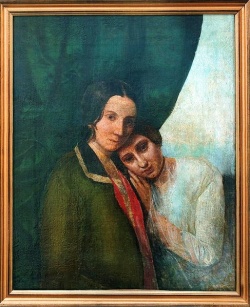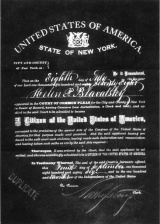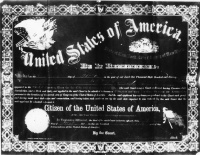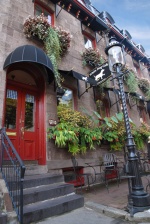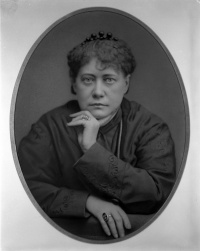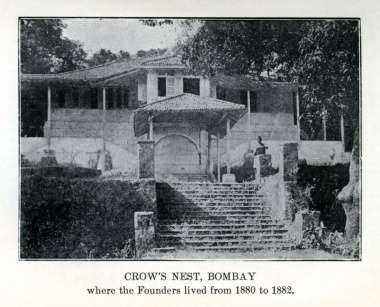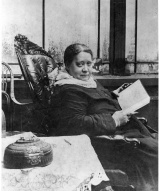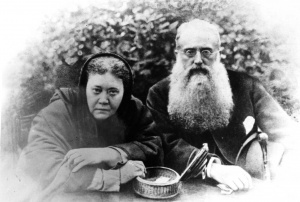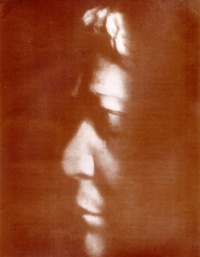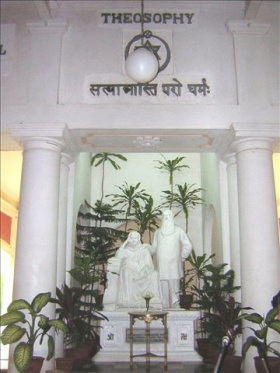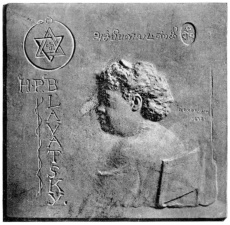Osmar de Carvalho/Sandbox: Difference between revisions
| Line 48: | Line 48: | ||
=== Encontro com Mestre Morya === | === Encontro com Mestre Morya === | ||
Em seu caderno de anotações, agora no Arquivo Adyar, Mme. Blavatsky diz que conheceu seu mestre, [[Morya | Master M.]], | Em seu caderno de anotações, agora no Arquivo de Adyar, Índia, Mme. Blavatsky diz que conheceu seu mestre, [[Morya | Master M.]], pela primeira vez em corpo físico em Ramsgate, em seu vigésimo aniversário, [[August 12]], em 1851. No entanto, ela contou à Condessa [[ Constance Wachtmeister]] que "Ramsgate" era um disfarce, pois o encontro fora no Hyde Park, Londres. Ela disse a [[Alfred Percy Sinnett | A. P. Sinnett]] que isso foi "no ano da primeira embaixada do Nepal", isto é, em 1850. | ||
É quase certo que H.P.B. estava em Londres no verão de 1854, porque ela diz que ela encontrou novamente seu Mestre "na casa de um estranho na Inglaterra, onde ele veio na companhia de um nativo príncipe destronado". Este era sem dúvida o Príncipe Dhuleep Singh, Mahârâja de Lahore.<ref>Helena Petrovna Blavatsky, ''Collected Writings'' vol. I (Wheaton, Ill: Theosophical Publishing House, 1988), xli.</ref> | É quase certo que H.P.B. estava em Londres no verão de 1854, porque ela diz que ela encontrou novamente seu Mestre "na casa de um estranho na Inglaterra, onde ele veio na companhia de um nativo príncipe destronado". Este era sem dúvida o Príncipe Dhuleep Singh, Mahârâja de Lahore.<ref>Helena Petrovna Blavatsky, ''Collected Writings'' vol. I (Wheaton, Ill: Theosophical Publishing House, 1988), xli.</ref> | ||
Revision as of 05:34, 30 June 2017
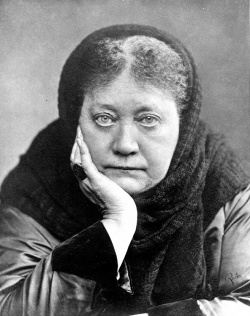
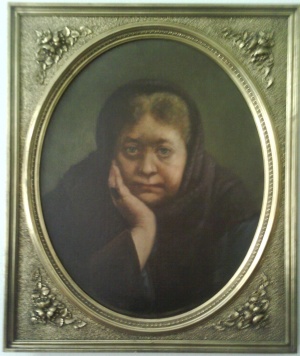
Helena Petrovna Blavatsky (Russo: Еле́на Петро́вна Блава́тская, Ucraniano: Олена Петрівна Блаватська), nasceu em Dnepropetrovsk (Ekaterinoslav), Ucrânia, em August 12, 1831 (31 de julho no calendário juliano). Foi uma Theosophist, escritora e viajante. Em 1875 (junto com o Coronel H. S. Olcott, o advogado William Quan Judge e outros) estabeleceu a Theosophical Society. Blavatsky foi a maior fonte dos Theosophical teachings e discutiu os maiores temas da Teosofia por meio da edição de inúmeros artigos e algumas obras seminais, incluindo Isis Unveiled, The Secret Doctrine, The Key to Theosophy, e The Voice of the Silence. Faleceu em Londres, em May 8, 1891. Blavatsky foi um instrumento na promoção da sabedoria espiritual do Oriente para o Ocidente e daqueles Antigos Mistérios orientais para o ocidente moderno, onde eram virtualmente desconhecidos.
Anos Iniciais
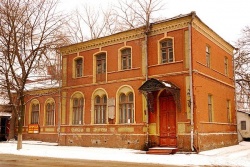
Helena Petrovna von Hahn (Russo: Елена Петровна Ган, Ukrainian: Олена Петрівна Ган) foi a primeira filha do Coronel Peter Alexeyevich von Hahn (1798-1873) e Helena Andreyevna Hahn (née de Fadeyev), uma bem conhecida romancista social. Nasceu em Ekaterinoslav no sul da Russia em August 12, 1831 (ou July 31 no calendário juliano, então vigente na Russia). Tendo nascido no sétimo mês do ano ela foi chamada "a Sedmitchka" (ou --Sedgmika), um termo não traduzível, que significa estar conectada com o número sete (outros apelidos seus eram "Lelinka" e "Lyolya", este último um diminutivo de Helena).
Embora nenhum registro oficial tenha sido produzido a com o horário exato de seu nascimento, foi determinado com suficiente acuidade por retificação astrológica, baseada em vários eventos importantes na vida de H.P.B., que este deu-se às 01h:42min A.M., horário local, o qual, equiparado à Greenwich, seria 11h:22min P.M., de 11 de Agosto de 1831.[1]
Helena nasceu prematuramente. Como em 1831 a Russia sofria de uma epidemia generalizada de cólera que assolou alguns membros da família de seu pai, havia temor pela vida da criança. Um batismo imediato foi celebrado, no qual uma criança que adormeceu segurando uma vela na primeira fileira à frente do sacerdote oficiante ateou fogo em seus paramentos durante a cerimônia.
Helena tinha uma irmã Vera Petrovna (April 29, 1835 - 1896) e um irmão, Leonid (June, 1840 - November 9, 1885).
De acordo com Vera P. de Zhelihovsky, sua mãe, na época estava preocupada com o destino de sua filha mais velha, "dotada desde a infância por características excepcionais".[2]
Os primeiros dez anos da vida de Helena foram gastos em frequentes mudanças de um lugar de residência para outro, em parte devido ao fato de que o batalhão de artilharia à cavalo de seu pai esteve de mudança de um lugar para outro, e particularmente devido à precária da saúde de sua Mãe.[3]
A mãe de Helena morreu de tubercoluse em July 6 de 1842 aos 28 anos. Antes de sua morte, sua mãe disse: "Bem! Talvez seja melhor que eu esteja morrendo: pelo menos, eu não vou sofrer ao ver as dificuldades de Helena! Estou certo de que seu destino não será feminino, que ela irá sofrer muito ".[4] Seu pai morreria em July 27 de 1873, depois de apenas três dias de enfermidade, enquanto HPB estava em Nova York pronta para iniciar sua carreira pública.
Após a morte de sua mãe, o avô de Helena, Andrei Mikhailovich e a avó Helena Pavlovna (que era um reconhecida cientista amadora) levaram as crianças para Saratov, onde tiveram uma vida bastante diferente. A casa de Fadeyev era visitada pelos intelectuais de Saratov.
Helena era clarividente desde a tenra infância. Em certas ocasiões ela viu a majestosa figura de um hindu trajando um turbante branco o qual ela chamou de seu "Protetor", uma vez que ele a salvou em situações de perigo. Um desses acidentes aconteceu quando ela era ainda criancinha. Querendo examinar uma foto pendurada no alto de uma parede, empilhou algumas mesas e uma cadeira e começou a escalá-las. Quando alcançou a pintura, perdeu o equilíbrio e não se lembrou de mais nada. Ela então recobrou a consciência em segurança no chão, e ambas as mesas e a cadeira estavam em seus lugares habituais, com o traço de uma pequena mão esquerda na parede empoeirada sob a imagem. Outra ocorrência sucedeu quando tinha 13 anos. Ela estava montando um cavalo que ficou assustado e disparou. Ela caiu de seu assento, seu pé ficou preso no estribo e ficou pendurada nele. Ao invés de ser morta, sentiu os braços de alguém ao redor de seu corpo apoiando-a até que o cavalo parasse.[5]
Primeiro Casamento
A temporada de inverno de 1848-49 foi passada em Tiflis na mansão dos antigos Principes Chavchavadze. Esforçando-se por sua plena independência, Helena, com 16 anos, noivou com o vice-governador de Erevan, Nikifor Vassilyevich Blavatsky, que tinha cerca de 40 anos. A cerimônia de casamento ocorreu em July 7 de 1849. Em outubro, Helena deixou seu marido e partiu a cavalo para Tiflis retornando para seus parentes. [6][7] Nikifor Blavatsky tentou obter um divórcio com o argumento de que "seu casamento nunca foi mais que uma formalidade". Sua tentativa falhou, no entanto, devido ao fato de a lei russa considerar desfavoravelmente o divórcio à época.
Não é certo quando Nikifor morreu. No diário de Helena há um recorte de jornal falando sobre sua vida, onde encontramos a frase: "Durante muitos anos eles [Helena e Nikifor] residiram juntos em Odessa e, finalmente, uma separação legal ocorreu". A este HPB adicionou duas notas. Um comentando sobre a sua estadia com o marido "por muitos anos" em que disse: "uma mentira - estive com ele por menos de três semanas". Para a segunda frase: "finalmente ocorreu uma separação legal", ela acrescentou: "legal, porque ele morreu". O nome e a data do jornal não aparecem na impressão, mas H.P.B. Escreveu em tinta acima do recorte: "Do N. Y. Mercury, 18 de janeiro de 1875".[8]
Viagens
Pouco depois de seu casamento, Mme. Blavatsky iniciou mais de 20 anos de extensivas viagens por todo o mundo, o que é extremamente difícil de rastrear por qualquer forma coerente. Entre 1848 e 1875 ela viajou ao redor do mundo por três vezes em busca de sabedoria sobre a natureza da vida e a finalidade da existência humana. Isso a colocou em contato com tradições místicas de todo o mundo. Uma vez que neste período de sua vida Blavatsky viajava sozinha, isto torna difícil para seus biógrafos o documentarem, embora tenha escrito e falado sobre suas aventuras em anos posteriores. N.A. Fadeyeva relatou que apenas seu pai sabia onde estava sua filha e, de tempos em tempos, enviava dinheiro para ela.
Aqui temos um relato cronológico em que ela esteve: Blavatsky’s travels.
Encontro com Mestre Morya
Em seu caderno de anotações, agora no Arquivo de Adyar, Índia, Mme. Blavatsky diz que conheceu seu mestre, Master M., pela primeira vez em corpo físico em Ramsgate, em seu vigésimo aniversário, August 12, em 1851. No entanto, ela contou à Condessa Constance Wachtmeister que "Ramsgate" era um disfarce, pois o encontro fora no Hyde Park, Londres. Ela disse a A. P. Sinnett que isso foi "no ano da primeira embaixada do Nepal", isto é, em 1850.
É quase certo que H.P.B. estava em Londres no verão de 1854, porque ela diz que ela encontrou novamente seu Mestre "na casa de um estranho na Inglaterra, onde ele veio na companhia de um nativo príncipe destronado". Este era sem dúvida o Príncipe Dhuleep Singh, Mahârâja de Lahore.[9]
No Tibet
The subject of Mme. Blavatsky’s stay in Tibet is wrapped in considerable mystery, as she kept the specific information secret. In 1884 she wrote the following:
I have lived at different periods in Little Tibet as in Great Tibet, and . . . these combined periods form more than seven years. Yet, I have never stated either verbally or over my signature that I had passed seven consecutive years in a convent. What I have said, and repeat now, is, that I have stopped in Lamaistic convents; that I have visited Tzi-gadze, the Tashi-Lhünpo territory and its neighbourhood, and that I have been further in, and in such places of Tibet as have never been visited by any other European, and that he can ever hope to visit.[10]
Sometime during 1852 she attempted to get into Tibet through Nepal. This first attempt failed through what she believed to be the opposition of the British Resident. When she tried to cross the Rangit river, she was see and brought her back.[11]
In 1855 she and some friends formed a plan to penetrate Tibet under various disguises. According to Mr. Sinnett, H.P.B. crossed into Tibetan territory, with the help of a Tartar Shaman who was on his way home to Siberia, while the others were prevented from carrying out their plan.[12]
It is presumed that sometime in 1868 H.P.B. went via India to some parts of Tibet. It is on this journey that she met Master K.H. for the first time, and lived in the house of his sister at Shigadze.[13]
On November 11, 1870, her aunt, Miss Nadyezhda Andreyevna de Fadeyev, received the first known letter from Master K.H. stating that H.P.B. was well and would be back with the family soon.
It is important to bear in mind the term Tibet was then used in a general manner that included not only Tibet proper, but also regions such as Ladakh (then known as Little Tibet).
Société Spirite
In 1871 Mme. Blavatsky embarked for Egypt from Greece, where she had seen Master Hillarion. The ship was carrying guns and gunpowder as a protection against pirates and on July 4, 1871, its powder magazine blew up, with a considerable loss of life. H.P.B., however, was uninjured. She eventually reached Alexandria with hardly any means at all. In October or November she went to Cairo where she met Emma Coulomb (then still Miss Emma Cutting) who was able to loan her some money for the time being.[14]
It was here that H.P.B. made a first attempt at investigating and explaining the nature of phenomena. For that purpose, she formed the Société Spirite (“Spiritist Society”) for the investigation of the Spiritism of the French occultist Allan Kardec. It would appear that this was done against the advice of Paulos Metamon, a well-known Coptic mystic and occultist with whom she was in touch at the time.[15] Her sister Vera de Zhelihovsky, who was in correspondence with her during these years, wrote that H.P.B. chose to start in this way “since there was no other [philosophy available]; to give people a chance to see for themselves how mistaken they were. She would first give room to an already established and accepted teaching and then, when the public would see that nothing was coming out of it, she would then offer her own explanations”.[16]
However, the Société Spirite failed within a fortnight as Blavatsky could not find honest and qualified mediums to do the kind of research she had envisioned.
Vida nos Estados Unidos
Probably in June, 1873, while in Paris, Mme. Blavatsky received an order from her Master to go to New York. She arrived in New York on July 7 and began to work designing illustrated advertising-cards. She also seems to have tried some ornamental leather work, artificial flowers, and cravats.
In July of 1874 Col. Henry S. Olcott became interested in Spiritualism and decided to investigate and report as a journalist the spiritualistic phenomena taking place at the Eddy farmhouse in Chittenden, Vermont. He went back to New York after a few days and published an account for the New York Sun. On September 17 he returned to Chittenden for further investigation and on October 14, acting on instructions received, HPB joined him, quickly becoming friends.
Through her occult training, Mme. Blavatsky had develop psychic abilities that allowed her to command the elementals (certain invisible powers of nature) through which she could perform many phenomena. Col. Olcott began to witness some of these abilities and naturally became very interested in this. As she began to instruct him in the Occult Science and the Esoteric Philosophy, the two started working together in connection with the Spiritualistic movement in the US. During this time, HPB performed at will many phenomena normally ascribed to “the spirits,” and published articles in different spiritualistic journals explaining the origin and nature of these psychic incidents, in ways that contradicted many of the Spiritualists' theories. Most spiritualists were not pleased with HPB’s attempt to reform, sometimes quite radically, their beliefs.
See also: Phenomena
Cidadania Americana
On September 22, 1874, Mme. Blavatsky signs a U.S.A. Government application form expressing her intention to become naturalized.
On July 8, 1878, "Helen P. Blavatsky" appeared in the Court of Common Pleas in New York City and completed the process of applying for citizenship in the United States. She was the first Russian woman to be naturalized as an American citizen.
According to Boris de Zirkoff in 1978, her naturalization papers were in the hands of Geoffrey Watkins[17], who was the son of John Watkins, a personal friend of Blavatsky[18].
Segundo Casamento
On April 3, 1875, a few months before founding the Theosophical Society, Mme. Blavatsky married a Georgian importer living in Philadelphia, Michael C. Betanelly. The wedding was conducted by Rev. William H. Furness at the First Unitarian Church of Philadelphia.[19] She had agreed to this marriage after her suitor agreed that she could retain her name and independence, and that it was a marriage in name only. Colonel Olcott was astonished at the situation and she later told him that the situation resulted from karmic complications from past lives.[20] The marriage broke off after several months and Betanelly sued for divorce, which was finally granted on May 25, 1878, with William Q. Judge acting as Blavatsky's counsel.
O Cachorro Branco
In 1875 Mme. Blavatsky resided at 3420 Sansom Street, in Philadelphia, PA. During the last days of January she injured her leg and her knee. By the middle of April John King cured the leg, but the trouble returned owing to lack of rest. By May her leg grew worse, becoming paralyzed and doctors and surgeons said the leg should be amputated. She dismissed their advice saying, "Fancy my father's daughter--on a wooden leg--fancy my leg going in the spirit land before me!"[21]
A message precipitated from John King claimed that he would cure it. On June 3, at midnight, HPB laid cold, pulse-less, and rigid; her injured leg had swollen to twice the natural size and had turned black. Her physician had given her up and her attendants thought her to be dead. However, within a few hours, the swelling subsided and she revived. Her leg was cured after two days of cold poultices and having a white pup laying at night across it. The story of the white dog has entered into Philadelphia lore with a restaurant called "The White Dog Cafe" located since 1983 in the building where Blavatsky lived.
During that time HPB was very ill and, according to her husband Michael C. Betanelly, she sometimes appeared to be "dead". As it would appear from Master Serapis' letters to Col. Olcott she underwent a serious trial or initiation. By the end of June, HPB had recovered fully.
O Clube dos Milagres
While living in New York, Mme. Blavatsky started publishing some articles and letters on Spiritualism, Magic, and Occultism. According to Col. Olcott this and "the stories that were afloat about her magical powers, and our several affirmations of the existence of non-human races of spiritual beings, drew into our acquaintanceship numbers of bright, clever people of occult leanings".[22] At this time Mme. Blavatsky recorded the following in her scrap-book:
An attempt in consequence of orders received from T*** B*** through P*** personating John King. Ordered to begin telling the public the truth about the phenomena and their mediums. And now my martyrdom will begin! I shall have all the Spiritualists against me, in addition to the Christians and the Sceptics. Thy will, oh M., be done. H.P.B.[23]
In May 1875 it was decided to form a private investigating committee under the title of the "Miracle Club" where the phenomena of spiritualism would be studied, tested, and demonstrated; "All the manifestations, including materialisations, to occur in the light, and without a cabinet".[24] This attempt, however, failed, mainly because the medium that was to be involved wanted to earn money from this endeavor, something HPB always opposed.
Fundação da Sociedade Teosófica
In July 1875, HPB wrote in her scrapbook: "Orders received from India direct to establish a philosophico-religious society and choose a name for it, also to choose Olcott."[25]
On September 7, sixteen or seventeen people joined HPB in her rooms at 46 Irving Place to hear a lecture by George H. Felt on "The Lost Canon of Proportion of the Egyptians, Greeks and Romans." The talk was enthusiastically received and H. S. Olcott wrote on a slip of paper "Would it not be a good thing to form a society from this kind of study?" He handed it to W. Q. Judge to pass it to HPB, who nodded in assent.[26]
At subsequent meetings bylaws were decided upon and officers were elected, with Col. Olcott as President, G. H. Felt and Dr. Seth Pancoast as Vice-Presidents; Madame Blavatsky, Corresponding Secretary; and W. Q. Judge as Counsel to the Society.
On November 17, seventy days after the formation of the Society was proposed, Col. Olcott gave his inaugural address as President-Founder of the newly formed Theosophical Society.
See also Founding of the Theosophical Society.
A "Lamaseria"
Since June 1876 till December 1878 Mme. Blavatsky and Col. Olcott lived in an apartment situated at 302 West 47th Street in New York. Known as the "Lamasery", the place became the unofficial headquarters of the newly formed Theosophical Society and a center of attraction for people interested in Occultism, Kabbalah, Spiritualism, Platonism, as well as those curious about phenomena. Col. Olcott and Mr. Judge were nearly always present, and, after the departure of the visitors would remain far into the night immersed in study and discussion.
See also The Lamasery.
Ísis Sem Véu
H. P. Blavatsky's first major literary effort was Isis Unveiled, a critical response to the growing materialism in both scientific and religious institutions. The book was started in 1875, a few months before the formation of the Theosophical Society, although at the time HPB did not know what was to become of the growing pile of manuscripts.
Described as "A Master-Key to the Mysteries of Ancient and Modern Science and Theology," the book was published in two volumes on September 29, 1877, quickly becoming a classic in occult literature. Two large editions of this "epoch-making" work were sold immediately, and new editions have been appearing ever since.
On December 18, 1878, five months after being officially naturalized as a U.S. citizen, Mme. Blavatsky (along with Col. Olcott, Edward Wimbridge, and Rosa Bates left for India via England. She would not return to the country again. The party arrived in London on January 3, 1879, and spent two weeks at the house of Dr. and Mrs. Billing. They sailed for Bombay on January 19.
Vida na Índia
Chega à Bombaim
Mme. Blavatsky and the party arrived in Bombay on February 16, 1879. In October of this year she started publishing The Theosophist. On December 4 the Founders visited A. P. Sinnett, editor of The Pioneer, who would become an important figure in the early Theosophical Society. A second visit was paid in 1880 where Mme. Blavatsky performed many wonderful phenomena that Mr. Sinnett described in his book The Occult World.
During 1880 Mme. Blavatsky suffered much personal attacks concerning her identity and antecedents. Being Russian and earning money from publication of stories in Russian newspapers, the British government feared she was a Russian spy.
Tomando o Pansil
On May 25, 1880, at the invitation of two head Buddhist monks of Ceylon (Sri Lanka), Mme. Blavatsky and a group of Theosophists went to the island. Here they "took Pansil", that is, they formally identified themselves with Buddhism by reciting the Five Precepts at the Vijayananda Temple in Galle.
Período "Crow's Nest"
By the end of December 1880, after their second visit to the Sinnetts, Mme. Blavatsky and Col. Olcott moved to a spacious house on the hill of Breach Candy, Bombay, nicknamed the "Crow's Nest". This became a great center of Theosophical activity, phenomena, and visitations by the Masters of Wisdom.
In July 1882 Mme. Blavatsky traveled incognito to go into Sikkim. At about thirty miles into Sikkim territory she met physically Masters M. and K.H. with whom she spent two days. The latter, wrote about this in one of his letters:
I do not believe I was ever so profoundly touched by anything I witnessed in all my life, as I was with the poor old creature’s ecstatic rapture, when meeting us recently both in our natural bodies, one — after three years, the other — nearly two years absence and separation in flesh. Even our phlegmatic M. was thrown off his balance by such an exhibition — of which he was chief hero. He had to use his power, and plunge her into a profound sleep, otherwise she would have burst some blood-vessel including kidneys, liver and her “interiors” — to use our friend Oxley’s favourite expression — in her delirious attempts to flatten her nose against his riding mantle besmeared with the Sikkim mud! We both laughed; yet could we feel otherwise but touched?[27]
Período Adyar
On April 23, 1882, the Founders arrived by ship at Madras, where they met T. Subba Row, and others. On May 31 they were taken to see a piece of property as a possible new headquarters for the Theosophical Society. When Mme. Blavatsky saw the Estate she declared "Master wants this purchased".[28]
On December 17 Mme. Blavatsky and Col. Olcott left Bombay by train heading for Adyar, accompanied by the Emma and Alexis Coulomb, Damodar, "Mr. Deb", Dora Swami Naidu, and five Hindu servants. They arrived on the 19th, 1882.
In 1883 she passed most of her time editing The Theosophist (which was the main source of Theosophical teachings at the time) and answering correspondence. It also fell to her to take charge of both chelas and lay chelas.[29]
In the second part of the year she spent about three months in the "Blue Mountains" (Nilgiri Hills) investigating the primitive Toda people living there. Her account was eventually published in book form under the title of The People of the Blue Mountains.
Visitando a Europa
At a council meeting on January 20, 1884, it was decided that Mme. Blavatsky should accompany Col. Olcott on his trip to Europe, partly for reasons of health. Before leaving the President issued a special order designating some members of the General Council to act as a Board of Control during his absence to take care of the official business.
They left Adyar and reached Marseilles on March 13. HPB stayed in France for about three week, mostly in Paris. On April 7, she unexpectedly appeared at the election of officers in the London Lodge.
On August 17 she visited the Gebhard Family at Elberfeld, Germany. It was here that she heard from Damodar K. Mavalankar in Adyar about the attack from the Missionaries, incited by Emma Coulomb, accusing HPB of having fraudulent phenomena.
Mme. Blavatsky left for India from Liverpool on October 5, 1884, accompanied by Isabelle Cooper-Oakley and her husband. They were joined by C. W. Leadbeater at Port Said, in north east Egypt. After stopping in Cairo, they went to Ceylon (Sri Lanka) and joined Col. Olcott there. They arrived at Adyar on December 17, 1884.
O Relatório Hodgson
In 1884, while the Founders were in Europe the members of the Board of Control at Adyar could not tolerate Emma Coulomb any longer. They asked her to leave and she planned to take revenge. She and her husband Alexis went to the missionaries in Madras (now Channai) and organized an attack on Mme. Blavatsky.
When HPB arrived at Madras on December 17 she received a tumultuous reception. She spoke in Pachaiappa's Hall packed with supporters, and declared that Emma Coulomb's letters, as they stand, had not been written by her.
The Society for Psychical Research (S.P.R.) decided to send young Richard Hodgson to Adyar to investigate Mme. Blavatsky's phenomena, the production of the Mahatma Letters, and the Coulomb's accusations. He arrived at Adyar in November, 1884, were he was friendly received. However, he began to be deceived by Emma and her husband into believing that she had faked them.
In April 1885 Hodgson returned to London. At the General Meeting of the S.P.R. held on June 24 he presented a 200-page report declaring that Mme. Blavatsky was one of the most gifted, ingenious and interesting impostors in history.
Although her reputation was seriously damaged due to this report, the next years of her life can be regarded as the most productive in her role as a spiritual teacher.
In January 1885, while in Adyar, Mme. Blavatsky's became seriously ill. One night when she was about to die when Master M. came and laid his hands upon her to bring her back from death.[30] Unable to perform any administrative duties due to her health, on March 21 1885 she resigned as Corresponding Secretary of the Theosophical Society.
Eventually, partly because of her health and partly to diffuse the effects of the accusations brought by the Coulombs, Mme. Blavatsky was "sent to Europe", in spite of her protests.
That this move had been contemplated by the Masters for some time can be ascertained from a letter Master K.H. wrote to A. P. Sinnett in October, 1884. In reference to Mme. Blavatsky, he stated:
She is permitted to retire for three reasons (1) to disconnect the T.S. from her phenomena, now tried to be represented all fraudulent; (2) to help it by removing the chief cause of the hatred against it; (3) to try and restore the health of the body, so it may be used for some years longer.[31]
See also: Hodgson Report
Vida na Europa
On March 31, 1885, Mme. Blavatsky sailed away from India, never to return. With her went Babaji, Dr. Hartmann, and Mary Flynn to look after her.
She stayed in Torre del Greco, Italy, for about three months and in August then decided to go to Wurzburg, near Munich, Germany. With the regaining of her health she started to become involved in the administration of the TS in Europe and she started working in a systematic way on her next book, The Secret Doctrine.
A Doutrina Secreta
In May 1879, soon after moving to India, Mme. Blavatsky started designing a new book on Theosophy that would eventually become The Secret Doctrine.
In January 1884 the Supplement to The Theosophist published an advertising announcing that "a New Version of Isis Unveiled", which was to be published in monthly. Although Mme. Blavatsky had some written material to start the monthly installments, this never came to fruition in the way planned, due to ill-health, her travel to Europe, and the Coulomb affair.
In the fall of 1885, a few months after HPB moved to Wurzburg, Germany, she started working steadily on its writing. The Countess Wachtmeister moved with HPB to help her in this endeavor. As the writing of the book developed with the help of Masters M. and K.H., HPB realized it was much more than a rewriting of Isis Unveiled. In a letter to A. P. Sinnett she said she felt that this could vindicate the Theosophical Society after the unfavorable Report that Hodgson made.[32]
In the spring of 1886 she sent a preliminary manuscript of the first volume to Adyar, where T. Subba Row was supposed to read it and contribute in what had to do with Hindu philosophy. However, he refused to do so. HPB moved to Ostende, Belgium, where she continued working on the book.
The First Volume of The Secret Doctrine came off the Press on October 20, 1888, while the Second Volume was out towards the end of the year.
Doença de Bright
By the end of March 1887 she fell gravely ill with a kidney infection. She was not expected to live. Master M. came at night and asked her if she wanted to be freed from the body or live, amidst much suffering, finish The Secret Doctrine and do some more work for Theosophy in Europe. She agreed on finishing the book. On May 1, 1887, at the invitation of Archibald and Bertram Keightley she moved to London. She settled with a few devoted friends in Lansdowne Road, Notting Hill, in September 1887.[33] A group of earnest students took care of her and helped her finish and publish her book.
Loja Blavatsky
Soon after Mme. Blavatsky arrived in London the group of student that had gathered around her convinced her of the need to form a TS Lodge. This was done, and they called it "The Blavatsky Lodge of the Theosophical Society". In addition, they decided to form a Theosophical Publishing Company and start a Theosophical journal they daringly called Lucifer, with HPB and Mabel Collins as editors. HPB wrote many articles for this.
After the publishing of The Secret Doctrine the Lodge met regularly to discuss with HPB any obscure points they found in its first volume. The dialogues they held were partially published under the title Transactions of the Blavatsky Lodge and later a complete version was published as The Secret Doctrine Commentaries. In these meetings the content of another important book by HPB, The Key to Theosophy was also discussed before its publication.
Seção Esotérica
On October 9, 1888, as a response to the demand by many earnest members to have esoteric teachings given by H. P. Blavatsky, Col. Olcott agreed to form the "Esoteric Section of the Theosophical Society" with Mme. Blavatsky as its responsible head.
In August 1890 she formed an "Inner Group" of this Section mainly with some of her students living in London at the time. The group held its meetings weekly in HPB's place, at 19 Avenue Rd, in a room specially built for it. Participants would ask questions in regards to the Esoteric Philosophy or the spiritual practice and HPB would answer.
A Voz do Silêncio
In July, 1889, Mme. Blavatsky went to Fontainebleau, France, for a few week's rest. There she wrote most of the material that would turn into the mystical Theosophical work known as The Voice of the Silence. This book is a translation of three treatises contained in a secret work, The Book of the Golden Precepts, which she had learned by heart during her training in Tibet.
During this time HPB received a visit from the newly joined Herbert Burrows and Annie Besant. In regards to the writing of this book, Mrs. Besant said:
She wrote it swiftly, without any material copy before her. I sat in the room while she was writing it. I know that she did not write it referring to any books, but she wrote it down steadily, hour after hour, exactly as though she were writing either from memory or from reading it where no book was and in the evening made me read it aloud to see if the 'English was decent.' Herbert Burrows was there, and Mrs. Candler, a staunch American Theosophist, and we sat round HPB while I read. The translation was in perfect and beautiful English, flowing and musical; only a word or two could we find to alter, and she looked at us like a startled child, wondering at our praises—praise that any one with the literary sense would endorse if they read that exquisite prose poem.[34]
Outros Escritos
There exists no definite evidence that Mme. Blavatsky had ever published any articles, essays or letters to Editors prior to October, 1874, although there are statements that seem to indicate that her literary work began much earlier in life. Besides the books she wrote, for much of her adult life HPB supported herself by writing travelogues and stories for Russian periodicals.
For a list of her books and other writings, see Blavatsky writings.
Morte
In April, 1891, a very serious epidemic of influenza struck London. Practically the entire staff at 19 Avenue Rd. was affected, with three of them being at death's door. On April 25th, H.P.B. had a very high fever. On the 30th, she developed an abscess in her throat, and then another on the bronchial tubes, and became progressively weaker. On May 6 she somewhat improved and managed to walk into her sitting room, although she said she felt she was dying. However, on May 8, at 11 a.m., H.P.B. grew worse. Seated in her chair, she passed away at 2:25 p.m., GMT, surrounded by Miss Laura Cooper, Claude Falls Wright, Walter Gorn Old, and Miss Black, the nurse.[35] The Countess Constance Wachtmeister and Isabel Cooper-Oakley arrived just after she passed. Miss Cooper left a detailed account of the event.[36]
H.P.B. had left instructions that "no parade or show of any kind should be made over her body."[37] Her body was cremated at Woking Crematorium, Surrey, on May 11, 1891. G. R. S. Mead, General Secretary of the European Section and H.P.B.'s private secretary, addressed the small assembly of officers, staff, and friends, and then the ashes were returned to her own rooms.[38]
Between May 8 and 9 Col. Olcott had three distinct warnings about Mme. Blavatsky's passing. He received a cablegram about the fact on May 10.
On July 9, 1891, the First Annual Convention of the European Branches was held in London. W. Q. Judge offered a resolution for the creation of an "H.P.B. Memorial Fund". Col. Olcott, as Chairman, suggested the partition of H.P.B.'s ashes. Some of the ashes are buried under the Blavatsky and Olcott statues in the Adyar headquarters that they had established in 1882.
Homenagens e Memorial
Almost every year, the Theosophical Society in England sponsors another in its series of Blavatsky Lectures, delivered by some of the best speakers in the Theosophical world.
The first Blavatsky Lodge was in London, but similar names have also been adopted by groups in Sydney, Auckland, Berlin, Brussels, Colombia, Vancouver, Mumbai, Richmond (BC), and at least seven groups in the Theosophical Society in America. The name Blavatsky Hall has been used in London, Mumbai, Chennai, Los Angeles, San Diego, and San Francisco. Blavatsky Avenue is found in Jakarta and in Adyar, Chennai. The Blavatsky Study Centre is at the Mt. Helena Retreat near Perth, Australia.
H. P. Blavatsky House-Museum in Dnepropetrovsk, Ukraine is a museum located in the house in which HPB was born. The Blavatsky Study Centre is at the Mt. Helena Retreat near Perth, Australia. The H. P. B. Library in Canada was founded by Alice L. Cleather, who also helped establish the Blavatsky Association that existed from 1923 to 1945.
A brief summary of her continued influence in many countries can be found at "H.P.Blavatsky's heritage in the modern world".
Contos Dramáticos e Ficção
Madame Blavatsky continues to fascinate modern writers, and is frequently mentioned in plays, popular fiction, Web-based fan fiction, and blog postings. Here are some examples:
- Serra, Francesca Serra. La grande Blavatsky. 2016. Italian novel.
Pinturas e Esculturas de HPB
American sculptor William R. O’Donovan created a bronze medallion of Madame Blavatsky while the Founders were still in New York. It appeared as the frontispiece in the first volume of Old Diary Leaves.
Fontes Online
For online resources of Helena Petrovna Blavatsky's writings see Blavatsky writings.
Artigos e Panfletos
- H. P. Blavatsky in Theosopedia.
- Blavatsky and Mount Rushmore by John Algeo
- H. P. Blavatsky - the Light-Bringer by Geoffrey A. Barborka
- HPB - Chronological Review of Events in her Life published by Blavatsky Study Center
- The Theosophical Society and H.P.B. by Annie Besant and H.T. Patterson
- The Truth About Madame Blavatsky by Walter A. Carrithers, Jr.
- How She Left Us by Laura M. Cooper
- The Esoteric She by William Q. Judge
- H.P.B. - A Lion-Hearted Colleague Passes by William Q. Judge
- H.P.B. at Enghien by William Q. Judge
- H.P.B. Was Not Deserted by the Masters by William Q. Judge
- "Yours Till Death and After, H.P.B." by William Q. Judge
- Address Read at the Cremation of HPB's Body by G. R. S. Mead
- Concerning H.P.B. - Stray Thoughts on Theosophy by G.R.S. Mead
- A Message Ahead of Its Time by Hugh Shearman
- New Light on the First Marriage of HPB by Marina Cesar Sisson
- Against Blavatsky: Rene Guenon's Critique of Theosophy by Richard Smoley
- Praise for H.P. Blavatsky and Theosophy at BlavatskyTheosophy.com
Livros
- Reminiscences of H.P. Blavatsky and The Secret Doctrine by Countess Constance Wachtmeister
Áudio
- The Real Madame Blavatsky by John Algeo
- Olcott and Blavatsky: Theosophical Twins by John Algeo
- H. P. Blavatsky Remembered: White Lotus Day Commemoration by David Bruce
- The Life of HPB Boris de Zirkoff
- H. P. Blavatsky: Woman of Mystery by Stephan Hoeller
Vídeo
Fontes Adicionais
- H. P. Blavatsky - Theosophical Topics in Depth Links to articles, letters, and books on and by HPB.
- Refutation of charges against Madame Blavatsky at Blavatsky Net.
- H. P. Blavatsky's Natal Chart at Astrodienst.
- Helena Petrovna Blavatsky Natal Horoscope at Khaldea.
- Articles, books and quotations from HPB in Russian language at Теопедия (Teopedia).
Notas
- ↑ Helena Petrovna Blavatsky, Collected Writings vol. I (Wheaton, IL: Theosophical Publishing House, 1988), xxvi.
- ↑ Желиховская. Е. П. Блаватская. II. С.246.
- ↑ Helena Petrovna Blavatsky, Collected Writings vol. I (Wheaton, IL: Theosophical Publishing House, 1988), xxx.
- ↑ Jelihovsky. Helena Petrovna Blavatsky // Lucifer. C.204; The Theosophist. C. 240
- ↑ Helene F. Pissareff, "Helena Petrovna Blavatsky," The Theosophist, 34:4 (January, 1913), 505-506.
- ↑ New Light on the First Marriage of HPB by Marina Cesar Sisson
- ↑ исьмо А. М. Дондукову-Корсакову от 1 марта 1882 года // Блаватская Е. П. «Письма друзьям и сотрудникам». Сборник. Перев. с англ. — М., 2002. — С. 250 ISBN 5-93975-062-1
- ↑ Helena Petrovna Blavatsky, Collected Writings vol. I (Wheaton, Ill: Theosophical Publishing House, 1988), 54.
- ↑ Helena Petrovna Blavatsky, Collected Writings vol. I (Wheaton, Ill: Theosophical Publishing House, 1988), xli.
- ↑ Helena Petrovna Blavatsky, Collected Writings vol. VI (Wheaton, IL: Theosophical Publishing House, 1989), 272.
- ↑ Helena Petrovna Blavatsky, Collected Writings vol. I (Wheaton, Ill: Theosophical Publishing House, 1988), xl.
- ↑ Helena Petrovna Blavatsky, Collected Writings vol. I (Wheaton, Ill: Theosophical Publishing House, 1988), xlii.
- ↑ Helena Petrovna Blavatsky, Collected Writings vol. I (Wheaton, Ill: Theosophical Publishing House, 1988), xlviii.
- ↑ Helena Petrovna Blavatsky, Collected Writings vol. I (Wheaton, Ill: Theosophical Publishing House, 1988), xlix.
- ↑ Helena Petrovna Blavatsky, Collected Writings vol. I (Wheaton, Ill: Theosophical Publishing House, 1988), xlix.
- ↑ John Algeo (ed.), The Letters of H. P. Blavatsky. (Wheaton: Theosophical Publishing House, 2003), 21.
- ↑ Boris de Zirkoff letter to Dora Kunz. October 17, 1978. Boris de Zirkoff Papers. Records Series 22. Theosophical Society in America Archives.
- ↑ "History of Watkins" at WatkinsBooks.com
- ↑ GBC letter to Boris de Zirkoff, dated March 9, 1956. Boris de Zirkoff Papers. Records Series 22. Theosophical Society in America Archives. The church was located at Chestnut and Van Pelt Street, and the pastor described HPB as Russian, aged 36 [she was actually 43] and her husband as Russian, aged 33.
- ↑ Charles J. Ryan, H. P. Blavatsky and the Theosophical Movement (Pasadena: Theosophical University Press), 55.
- ↑ John Algeo, The Letters of H. P. Blavatsky Letter No. 47, (Wheaton, IL: The Theosophical Publishing House, 2003), 176-177.
- ↑ Henry Steel Olcott, Old Diary Leaves First Series (Adyar, Madras: The Theosophical Publishing House, 1974), 113-114.
- ↑ Henry Steel Olcott, Old Diary Leaves First Series (Adyar, Madras: The Theosophical Publishing House, 1974), 25.
- ↑ Henry Steel Olcott, Old Diary Leaves First Series (Adyar, Madras: The Theosophical Publishing House, 1974), 25-26.
- ↑ Daniel H. Caldwell, The Esoteric World of Madame Blavatsky (Wheaton, Ill., Quest Books, 2001), 71
- ↑ Sylvia Cranston, H.P.B. The Extraordinary Life & Influence of Helena Blavatsky, (New York: Putnam Book, 1993), 143.
- ↑ Vicente Hao Chin, Jr., The Mahatma Letters to A.P. Sinnett in chronological sequence No. 92 (Quezon City: Theosophical Publishing House, 1993), ???.
- ↑ Old Diary Leaves by G. Subbiah Chetty
- ↑ Josephine Ransom, A Short History of The Theosophical Society (Adyar, Madras, India: The Theosophical Publishing House, 1989), 178.
- ↑ Josephine Ransom, A Short History of The Theosophical Society (Adyar, Madras, India: The Theosophical Publishing House, 1989), 218.
- ↑ Vicente Hao Chin, Jr., The Mahatma Letters to A.P. Sinnett in chronological sequence No. 130 (Quezon City: Theosophical Publishing House, 1993), 434.
- ↑ A. Trevor Barker, The Letters of H. P. Blavatsky to A. P. Sinnett Letter No. CXVI, (Pasadena, CA: Theosophical University Press, 1973), 79.
- ↑ The Vahan. January 1, 1891.
- ↑ Annie Besant, The Masters, (Adyar, Madras: The Theosophical Press, 1977), 32-33.
- ↑ Daniel H. Caldwell, The Esoteric World of Madame Blavatsky: Insights into the Life of a Modern Sphinx (Wheaton:Quest Books, 2001), 396-397.
- ↑ Laura M. Cooper, "How She Left Us," H.P.B.: In Memory of Helena Petrovna Blavatsky (London: Theosophical Publishing Society, 1891), 3-7.
- ↑ G. R. S. Mead,"The Cremation," H.P.B.: In Memory of Helena Petrovna Blavatsky (London: Theosophical Publishing Society, 1891), 7.
- ↑ G. R. S. Mead,"The Cremation," 8-11. Available at [https://archive.org/stream/hpbinmemoryhele00unkngoog/hpbinmemoryhele00unkngoog_djvu.txt Internet Archive.
